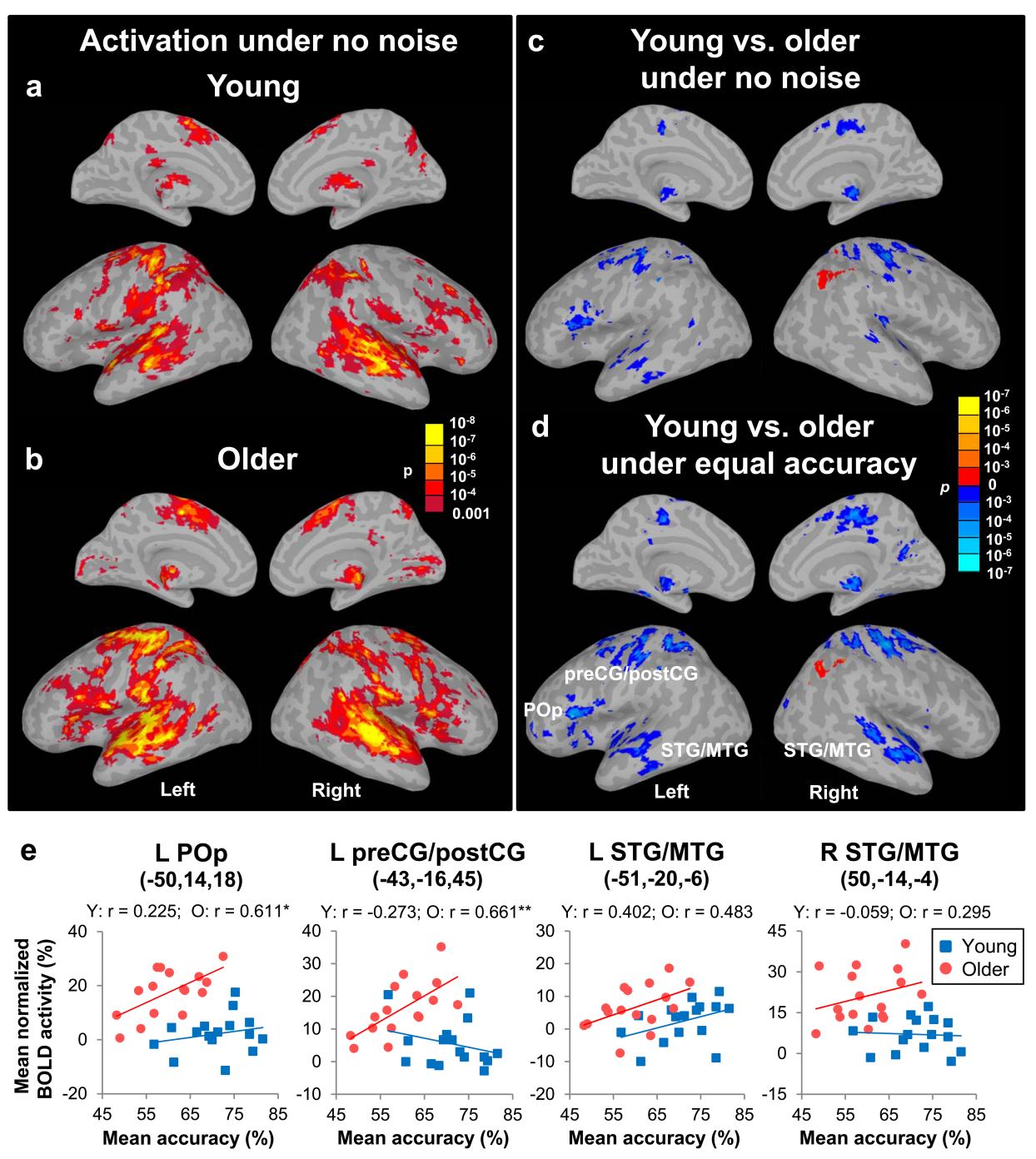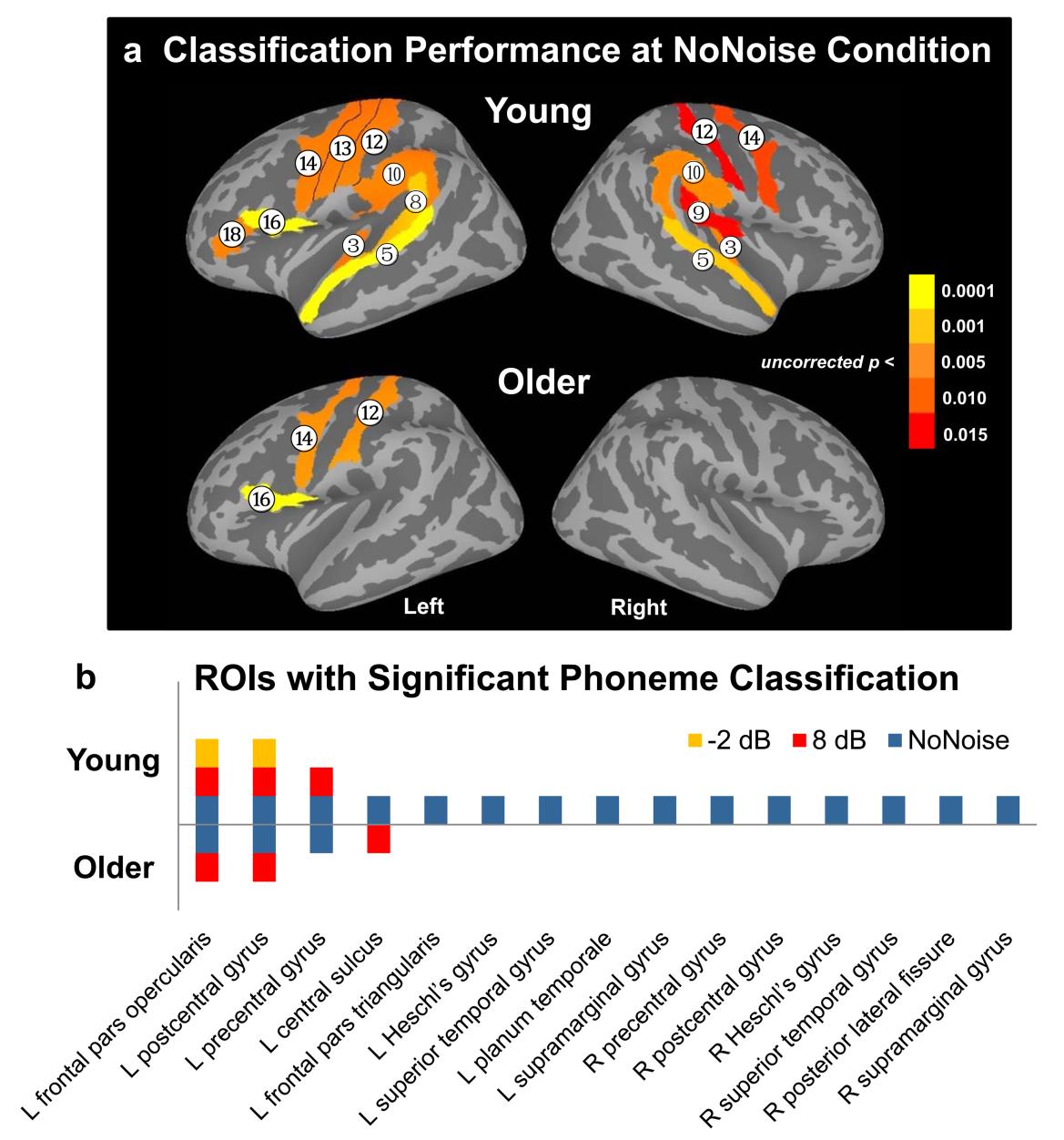心理所研究揭示发音相关脑区对老年人言语理解困难的代偿作用
听力损失是老年人最普遍的慢性健康问题之一,80岁以上老年人中约有90%存在不同程度的听力下降。听力损失会严重影响到老年人的生活质量和社会交往能力。日常生活中,我们不乏处于噪音环境,比如嘈杂的餐馆。研究表明,即使是听力正常的老年人在噪音环境下也会经历不同程度的言语理解困难。然而目前我们还不清楚,老年人的大脑如何在听力下降和噪音环境的双重挑战下知觉和理解他人的言语。
随着年龄的增加,我们的听觉外周(包括耳蜗和听神经)和听觉中枢系统(负责加工和理解声音的脑区)出现功能衰退。但可喜的是,作为一个动态的适应过程,老年人的大脑可能通过资源重组或认知策略改变以应对感知觉加工能力的下降。因此,老年人在噪音环境下加工和识别他人的言语时就需要调用更多的认知资源和脑区以作为一种代偿。
通过与加拿大多伦多大学和罗德曼研究所的国际合作,中国科学院行为科学重点实验室的杜忆研究员运用功能性磁共振成像技术发现,位于大脑前额叶的言语运动区(与言语的发音密切相关,包括布洛卡区和腹侧前运动皮层)对老年人在噪音环境下的语音分辨和识别具有重要的代偿作用。该研究发现最新发表于Nature Communications (doi: 10.1038/ncomms12241)。
该研究分析了16名20-34岁的年轻人和16名65-75岁的老年人在不同背景噪音强度下进行音节分辨时的大脑活动。结果发现,老年人的言语运动区比年轻人的言语运动区激活程度更高。而且,老年人言语运动区的激活程度与其任务成绩显著正相关(Figure 1)。使用一种叫做多体素模式分类的机器学习算法,他们进一步发现,即使在没有噪音干扰下,老年人的听觉皮层也无法对不同的音节形成特异性的神经表征。即老年人的听觉皮层对语音信号的编码呈现出同质化的特点。然而,老年人言语运动区的语音神经表征(可能通过对说话人发音姿势的预测所产生)却能在噪音干扰下保持一定程度的特异性(Figure 2)。这项研究证实了该团队前期在年轻人上的发现,即言语运动区比听觉皮层在噪音干扰下对语音信号的编码具有更高的刺激特异性(Du et al., 2014 PNAS, doi: 10.1073/pnas.1318738111)。更重要的是,这项研究提示,老年人在噪音环境下理解他人的言语时会更多地依赖与发音相关的言语运动脑区并采用一种预测性加工策略,即充分利用较少受到老年化和噪音影响的言语的发音知识和预期以代偿受损的听觉加工。
该研究具有重要的临床和工业意义,它为帮助听力受损的老年人设计和开展言语康复训练方案以及助听器等听力辅助设备的研发提供了新的视角和启发。比如,在知道发音相关脑区对老年人的言语理解具有重要的代偿作用后,研究人员可以针对该脑区设计相应的训练方案以提高其功能以及与其他脑区的功能连接。
该研究获得加拿大健康研究院基金支持。

Figure 1. Age difference in BOLD activity. Activity elicited by syllable identification at the NoNoise condition in young (a) and older adults (b). Activity in young adults vs. activity in older adults at the NoNoise condition (c) and conditions when two groups equaled in accuracy (average activity at -6 and -2 dB SNRs in young vs. average activity at -2 and 8 dB SNRs in older) (d). Results are thresholded at pFWE < 0.01. (e) Correlations between the mean activity across -12 to 8 dB SNRs in four ROIs (left POp, left preCG/postCG and bilateral STG/MTG) and the mean accuracy across those SNRs in older (red circles) and young adults (blue squares). The coordinates are in Talairach space. *, p < 0.05; **, p < 0.01 by Pearson’s correlations. POp, pars opercularis; preCG/postCG, precentral and postcentral gyrus; STG/MTG, superior and middle temporal gyrus.

Figure 2. Phoneme classification performance. (a) Regions with significant phoneme classification (area-under-the-curver (AUC) > 0.5, one-sample t test with false discovery rate corrected q < 0.05) at the NoNoise condition for each group. (b) Overview of ROIs and SNRs when significant classification was revealed in each group. SNRs at which each ROI showed significant classification are displayed on the y-axis, with ROI labels listed across the x-axis. The top half shows data from young adults and the bottom half shows data from older adults. 3, Heschl’s gyrus; 5, superior temporal gyrus; 8, planum temporale; 9, posterior lateral fissure; 10, supramarginal gyrus; 12, postcentral gyrus; 13, central sulcus; 14, precentral gyrus; 16, pars opercularis; 18, pars triangularis.
论文信息
Du Y, Buchsbaum B, Grady C, Alain C (2016). Increased activity in frontal motor cortex compensates impaired speech perception in older adults. Nature Communications, 7, 12241.
相关论文
Du Y, Buchsbaum B, Grady C, Alain C (2014) Noise differentially impacts phoneme representations in the auditory and speech motor systems. Proceedings of the National Academy of Sciences of the United States of America, 111, 7126-7131.
附件下载:

